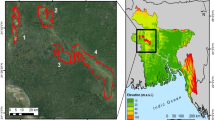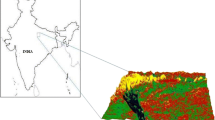Abstract
The aim of this study is to investigate the performance of fifteen automatic thresholding methods, namely Huang and Wang’s fuzzy thresholding method, inter-mode thresholding method, isodata thresholding method, Li and Tam’s thresholding method, maximum entropy thresholding method, mean thresholding method, minimum error thresholding method, minimum thresholding method, moment-preserving thresholding method, Otsu’s thresholding method, percentile (p-tile) thresholding method, Renyi’s entropy thresholding method, Shanbhag’s thresholding method, triangle thresholding method and Yen’s thresholding method, for mapping open water body using Sentinel-2 data based on Normalized Difference Water Index (NDWI). Sentinel-2 data was acquired on 22 September 2018 and Lake Salda from Turkey was selected as a test site. Due to the lack of digital reference data of the test site, Support Vector Machine (SVM) classification was implemented to Sentinel-2 data and the classified image was utilized as reference data since previous studies proved that SVM classification provided better results than the thresholding methods. SVM classification results were evaluated using 1000 random points and the Overall Accuracy (OA) and Kappa coefficient were obtained 96.2% and 0.90, respectively. The thresholding methods were assessed using the statistical measures, namely OA, Kappa and Misclassification Error (ME). Considering the remote sensing perspective, all thresholding methods presented satisfying results having at least 92% OA for open water body extraction. The obtained accuracy results showed that minimum thresholding method was the best method among these fifteen algorithms with 0.000264 ME, 99.9355% OA and 0.9987 Kappa. On the other hand, p-tile and Shanbhag’s thresholding method provided the worst accuracy results for open water body delineation.





Similar content being viewed by others

References
Gleick PH (1996) Encyclopedia of climate and weather. Water Resour 2:817–823
Sekertekin A, Cicekli SY, Arslan N (2018) Index-based identification of surface water resources using sentinel-2 satellite imagery. In: 2018 2nd International symposium on multidisciplinary studies and ınnovative technologies (ISMSIT), IEEE, pp 1–5. https://doi.org/10.1109/ISMSIT.2018.8567062
Kite G, Pietroniro A (2000) Remote sensing of surface water. In: Remote sensing in hydrology and water management, Springer, Berlin, pp 217–238
Schultz GA, Barret EC (1989) Advances in remote sensing for hydrology and water resources management. UNESCO, Paris
Xu F, Bao HXH, Li H et al (2016) Land use policy and spatiotemporal changes in the water area of an arid region. Land Use Policy 54:366–377. https://doi.org/10.1016/j.landusepol.2016.02.027
Mirhosseini M, Farshchi P, Noroozi AA et al (2018) An investigation on the effect of land use land cover changes on surface water quantity. Water Sci Technol Water Supply 18:490–503. https://doi.org/10.2166/ws.2017.107
Pekel J, Cottam A, Gorelick N, Belward AS (2016) High-resolution mapping of global surface water and its long-term changes. Nature 540:418–422. https://doi.org/10.1038/nature20584
Feyisa GL, Meilby H, Fensholt R, Proud SR (2014) Automated Water Extraction Index: a new technique for surface water mapping using Landsat imagery. Remote Sens Environ 140:23–35. https://doi.org/10.1016/j.rse.2013.08.029
Sekertekin A, Abdikan S, Marangoz AM (2018) The acquisition of impervious surface area from LANDSAT 8 satellite sensor data using urban indices: a comparative analysis. Environ Monit Assess 190:381. https://doi.org/10.1007/s10661-018-6767-3
Sarp G, Ozcelik M (2017) Water body extraction and change detection using time series: a case study of Lake Burdur, Turkey. J Taibah Univ Sci 11:381–391. https://doi.org/10.1016/j.jtusci.2016.04.005
Li W, Du Z, Ling F et al (2013) A comparison of land surface water mapping using the Normalized Difference Water Index from TM, ETM + and ALI. Remote Sens 5:5530–5549. https://doi.org/10.3390/rs5115530
Li Y, Gong X, Guo Z et al (2016) An index and approach for water extraction using Landsat–OLI data. Int J Remote Sens 37:3611–3635. https://doi.org/10.1080/01431161.2016.1201228
Sheng Y, Gong P, Xiao Q (2001) Quantitative dynamic flood monitoring with NOAA AVHRR. Int J Remote Sens 22:1709–1724. https://doi.org/10.1080/01431160118481
Wang Q, Watanabe M, Hayashi S, Murakami S (2003) Using NOAA AVHRR data to assess flood damage in China. Environ Monit Assess 82:119–148. https://doi.org/10.1023/A:1021898531229
Dewan AM, Islam MM, Kumamoto T, Nishigaki M (2007) Evaluating flood hazard for land-use planning in greater dhaka of bangladesh using remote sensing and GIS techniques. Water Resour Manag 21:1601–1612. https://doi.org/10.1007/s11269-006-9116-1
Bayik C, Abdikan S, Ozbulak G et al (2018) Exploiting multi-temporal sentinel-1 SAR data for flood extend mapping. In: The international archives of the photogrammetry, remote sensing and spatial information sciences, pp 18–21
Bortels L, Chan JC-W, Merken R, Koedam N (2011) Long-term monitoring of wetlands along the Western-Greek Bird Migration Route using Landsat and ASTER satellite images: Amvrakikos Gulf (Greece). J Nat Conserv 19:215–223. https://doi.org/10.1016/j.jnc.2011.01.004
Davranche A, Lefebvre G, Poulin B (2010) Wetland monitoring using classification trees and SPOT-5 seasonal time series. Remote Sens Environ 114:552–562. https://doi.org/10.1016/j.rse.2009.10.009
Güttler FN, Niculescu S, Gohin F (2013) Turbidity retrieval and monitoring of Danube Delta waters using multi-sensor optical remote sensing data: an integrated view from the delta plain lakes to the western–northwestern Black Sea coastal zone. Remote Sens Environ 132:86–101. https://doi.org/10.1016/j.rse.2013.01.009
Novoa S, Chust G, Sagarminaga Y et al (2012) Water quality assessment using satellite-derived chlorophyll-a within the European directives, in the southeastern Bay of Biscay. Mar Pollut Bull 64:739–750. https://doi.org/10.1016/j.marpolbul.2012.01.020
Song Y, Sohn H, Park C (2007) Efficient water area classification using radarsat-1 SAR ımagery in a high relief mountainous environment. Photogram Eng Remote Sens 73:285–296. https://doi.org/10.14358/PERS.73.3.285
Brisco B, Short N, Van Der Sanden J et al (2009) A semi-automated tool for surface water mapping with RADARSAT-1. Can J Remote Sens 35:336–344. https://doi.org/10.5589/m09-025
Verpoorter C, Kutser T, Tranvik L (2012) Automated mapping of water bodies using landsat multispectral data. Limnol Oceanogr Methods 10:1037–1050. https://doi.org/10.4319/lom.2012.10.1037
Yang Y, Liu Y, Zhou M et al (2015) Landsat 8 OLI image based terrestrial water extraction from heterogeneous backgrounds using a reflectance homogenization approach. Remote Sens Environ 171:14–32. https://doi.org/10.1016/j.rse.2015.10.005
Şekertekin A, Marangoz AM, Akçin H (2017) Extraction of surface water resources using remote sensing indices and Landsat 8 data. In: International symposıum on GIS applıcations in geography and geosciences, Çanakkale, Turkey, p 288
Hong S, Jang H, Kim N, Sohn H-G (2015) Water area extraction using RADARSAT SAR imagery combined with Landsat imagery and terrain information. Sensors 15:6652–6667. https://doi.org/10.3390/s150306652
Frazier PS, Page KJ (2000) Water body detection and delineation with landsat TM data. Photogramm Eng Remote Sens 66:1461–1467
Xie H, Luo X, Xu X et al (2016) Evaluation of Landsat 8 OLI imagery for unsupervised inland water extraction. Int J Remote Sens 37:1826–1844. https://doi.org/10.1080/01431161.2016.1168948
Zhang T, Yang X, Hu S, Su F (2013) Extraction of coastline in aquaculture coast from multispectral remote sensing images: object-based region growing integrating edge detection. Remote Sens 5:4470–4487. https://doi.org/10.3390/rs5094470
Jain SK, Singh RD, Jain MK, Lohani AK (2005) Delineation of flood-prone areas using remote sensing techniques. Water Resour Manag 19:333–347. https://doi.org/10.1007/s11269-005-3281-5
Liu X, Deng R, Xu J, Zhang F (2017) Coupling the modified linear spectral mixture analysis and pixel-swapping methods for improving subpixel water mapping: application to the Pearl River delta, China. Water 9:658. https://doi.org/10.3390/w9090658
Hong Z, Li X, Han Y et al (2018) Automatic sub-pixel coastline extraction based on spectral mixture analysis using EO-1 Hyperion data. Front Earth Sci. https://doi.org/10.1007/s11707-018-0702-5
McFEETERS SK (1996) The use of the Normalized Difference Water Index (NDWI) in the delineation of open water features. Int J Remote Sens 17:1425–1432. https://doi.org/10.1080/01431169608948714
Xu H (2006) Modification of normalised difference water index (NDWI) to enhance open water features in remotely sensed imagery. Int J Remote Sens 27:3025–3033. https://doi.org/10.1080/01431160600589179
Xu H (2005) A study on information extraction of water body with the Modified Normalized Difference Water Index (MNDWI). J Remote Sens 5:589–595
Ding F (2009) Study on information extraction of water body with a new water index (NWI). Sci Surv Mapp 4:155–157
Meng WC, Zhu SL, Cao W et al (2013) Establishment of synthetical water index. Sci Surv Mapp 4:130–133
Dhal KG, Das A, Ray S et al (2019) Nature-ınspired optimization algorithms and their application in multi-thresholding ımage segmentation. Arch Comput Methods Eng. https://doi.org/10.1007/s11831-019-09334-y
Thyagharajan KK, Vignesh T (2019) Soft computing techniques for land use and land cover monitoring with multispectral remote sensing ımages: a review. Arch Comput Methods Eng 26:275–301. https://doi.org/10.1007/s11831-017-9239-y
ImageJ (2019) Auto threshold. https://imagej.net/Auto_Threshold
Zhou Y, Luo J, Shen Z et al (2014) Multiscale water body extraction in urban environments from satellite images. IEEE J Sel Top Appl Earth Obs Remote Sens 7:4301–4312. https://doi.org/10.1109/JSTARS.2014.2360436
Zhai K, Wu X, Qin Y, Du P (2015) Comparison of surface water extraction performances of different classic water indices using OLI and TM imageries in different situations. Geosp Inf Sci 18:32–42. https://doi.org/10.1080/10095020.2015.1017911
Yin D, Cao X, Chen X et al (2013) Comparison of automatic thresholding methods for snow-cover mapping using Landsat TM imagery. Int J Remote Sens 34:6529–6538. https://doi.org/10.1080/01431161.2013.803631
Sekertekin A (2019) Mapping of surface water resources: a comparative analysis of eight image classification methods. In: Theoretical investigations and applied studies in engineering, Ekin Publishing House, Bursa, pp 269–284
Gao BC (1996) NDWI—a normalized difference water index for remote sensing of vegetation liquid water from space. Remote Sens Environ 58:257–266. https://doi.org/10.1016/S0034-4257(96)00067-3
Huang L-K, Wang M-JJ (1995) Image thresholding by minimizing the measures of fuzziness. Pattern Recognit 28:41–51. https://doi.org/10.1016/0031-3203(94)E0043-K
Gonzales-Barron U, Butler F (2006) A comparison of seven thresholding techniques with the k-means clustering algorithm for measurement of bread-crumb features by digital image analysis. J Food Eng 74:268–278. https://doi.org/10.1016/j.jfoodeng.2005.03.007
Iravani-Tabrizipour M, Toyserkani E (2007) An image-based feature tracking algorithm for real-time measurement of clad height. Mach Vis Appl 18:343–354. https://doi.org/10.1007/s00138-006-0066-7
Prewitt JMS, Mendelsohn ML (1966) The analysis of cell images. Ann N Y Acad Sci 128:1035–1053. https://doi.org/10.1111/j.1749-6632.1965.tb11715.x
Ridler TW, Calvard S, Ridler TW, Calvard S (1978) Picture thresholding using an ıterative selection method. IEEE Trans Syst Man Cybern 8:630–632. https://doi.org/10.1109/TSMC.1978.4310039
Li CH, Tam PKS (1998) An iterative algorithm for minimum cross entropy thresholding. Pattern Recognit Lett 19:771–776. https://doi.org/10.1016/S0167-8655(98)00057-9
Kapur JN, Sahoo PK, Wong AKC (1985) A new method for gray-level picture thresholding using the entropy of the histogram. Comput Vis Gr Image Process 29:273–285. https://doi.org/10.1016/0734-189X(85)90125-2
Shannon CE (1948) A mathematical theory of communication. Bell Syst Tech J 27:379–423. https://doi.org/10.1002/j.1538-7305.1948.tb01338.x
Glasbey CA (1993) An analysis of histogram-based thresholding algorithms. CVGIP Graph Model Image Process 55:532–537. https://doi.org/10.1006/cgip.1993.1040
Kittler J, Illingworth J (1986) Minimum error thresholding. Pattern Recognit 19:41–47. https://doi.org/10.1016/0031-3203(86)90030-0
Fang N, Cheng M-C (1993) An automatic crossover point selection technique for image enhancement using fuzzy sets. Pattern Recognit Lett 14:397–406. https://doi.org/10.1016/0167-8655(93)90118-W
Tsai W-H (1985) Moment-preserving thresolding: a new approach. Comput Vis Graph Image Process 29:377–393. https://doi.org/10.1016/0734-189X(85)90133-1
Otsu N (1979) A threshold selection method from gray-level histograms. IEEE Trans Syst Man Cybern 9:62–66. https://doi.org/10.1109/TSMC.1979.4310076
Doyle W (1962) Operations useful for similarity-ınvariant pattern recognition. J ACM 9:259–267. https://doi.org/10.1145/321119.321123
Samopa F, Asano A (2009) Hybrid image thresholding method using edge detection. J Comput Sci Netw 9:292–299
Sahoo P, Wilkins C, Yeager J (1997) Threshold selection using Renyi’s entropy. Pattern Recognit 30:71–84. https://doi.org/10.1016/S0031-3203(96)00065-9
Shanbhag AG (1994) Utilization of ınformation measure as a means of ımage thresholding. CVGIP Graph Model Image Process 56:414–419. https://doi.org/10.1006/cgip.1994.1037
Zack GW, Rogers WE, Latt SA (1977) Automatic measurement of sister chromatid exchange frequency. J Histochem Cytochem 25:741–753. https://doi.org/10.1177/25.7.70454
Yen JC, Chang FJ, Chang S (1995) A new criterion for automatic multilevel thresholding. IEEE Trans Image Process 4:370–378. https://doi.org/10.1109/83.366472
Sezgin M, Sankur B (2004) Survey over image thresholding techniques and quantitative performance evaluation. J Electron Imaging 13:146. https://doi.org/10.1117/1.1631315
Author information
Authors and Affiliations
Corresponding author
Ethics declarations
Conflict of interest
The author declares that he has no conflict of interest.
Additional information
Publisher's Note
Springer Nature remains neutral with regard to jurisdictional claims in published maps and institutional affiliations.
Rights and permissions
About this article
Cite this article
Sekertekin, A. A Survey on Global Thresholding Methods for Mapping Open Water Body Using Sentinel-2 Satellite Imagery and Normalized Difference Water Index. Arch Computat Methods Eng 28, 1335–1347 (2021). https://doi.org/10.1007/s11831-020-09416-2
Received:
Accepted:
Published:
Issue Date:
DOI: https://doi.org/10.1007/s11831-020-09416-2



